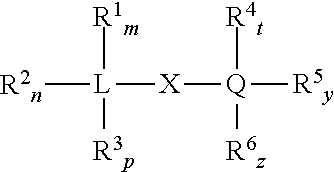Non-phthalate compounds as electron donors for polyolefin catalysts
- Summary
- Abstract
- Description
- Claims
- Application Information
AI Technical Summary
Benefits of technology
Problems solved by technology
Method used
Image
Examples
example 1
Synthesis of S,S-diisobutyl-1,2-benzenedicarbothioate
[0083]A 250 ml three-necked round bottom flask is charged with 100 ml anhydrous THF, 10.2 g (50 mmol) phthaloyl chloride and 10.5 g (117 mmol) 2-methyl-1-propanethiol. To this solution with stirring is added dropwise 30 ml THF solution of 9.5 g pyridine (120 mmol) over 20 minutes. After completion of the addition, the mixture is stirred at ambient temperature for 1 hour, and then heated refluxing for 4 hours. After the mixture is cooled to ambient temperature, the mixture is filtered and a clear solution is obtained. After the solvent and low boiling point impurity are removed at 100° C. under vacuum and the residue is cooled to ambient temperature, to the residue was added 30 ml ethyl acetate, and then added 20 ml saturated saline. The organic phase is separated and water phase extracted with 20 ml ethyl acetate twice. The combined organic phase was dried over anhydrous sodium sulfate. After removing the solvent, the crude produc...
example 2
Synthesis of benzenecarbothioic acid-S,S′-2,3-butanediyl ester
[0085]Synthesis procedure is the same as described in Example 1, except that 6.0 g (50 mmol) of 2,3-butanedithiol and 16.1 g (115 mmol) benzoyl chloride are used to replace 2-methyl-1-propanethiol and phthaloyl chloride, respectively. After purification, 11.2 g of colorless viscous oil is obtained. The name and structure of this compound is provided in Table 1.
[0086]1H-NMR (CDCl3 / TMS) δ (ppm): 1.49-1.54 (d, 6H, CH3), 4.21-4.25 (m, 2H, —SCH—), 7.41-7.97 (m, 10H, ArH).
example 3
Synthesis of 2,4-pentanediol diphenylglyoxylate
(1) Preparation of phenylglyoxyloyl chloride
[0087]A 250 ml two-necked round bottom flask is charged with 12.0 g (80 mmol) phenylglyoxylic acid and 41.0 g (320 mmol) oxalyl chloride. The mixture is heated and refluxed for 2 hours, and then stirred overnight at ambient temperature. After the excessive oxalyl chloride is removed out with distillation, the residue is cooled down and ready for the next step.
(2) Synthesis of 2,4-pentanediol diphenylglyoxylate
[0088]To the flask containing phenylglyoxyloyl chloride from step (1), is added 120 ml THF and 3.1 g 2,4-pentanediol (30 mmol). To this solution with stirring is added dropwise 30 ml THF solution of 12.0 g pyridine (150 mmol) over 30 minutes. After completion of the addition, the mixture is stirred at ambient temperature for 1 hour, and then heated refluxing for 4 hours. After the mixture is cooled to ambient temperature, the mixture is filtered and a clear solution obtained. The solution...
PUM
| Property | Measurement | Unit |
|---|---|---|
| Structure | aaaaa | aaaaa |
Abstract
Description
Claims
Application Information
 Login to View More
Login to View More - R&D
- Intellectual Property
- Life Sciences
- Materials
- Tech Scout
- Unparalleled Data Quality
- Higher Quality Content
- 60% Fewer Hallucinations
Browse by: Latest US Patents, China's latest patents, Technical Efficacy Thesaurus, Application Domain, Technology Topic, Popular Technical Reports.
© 2025 PatSnap. All rights reserved.Legal|Privacy policy|Modern Slavery Act Transparency Statement|Sitemap|About US| Contact US: help@patsnap.com



